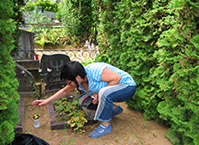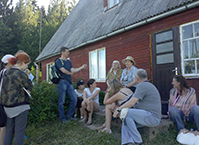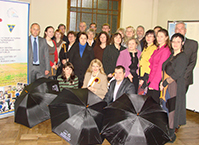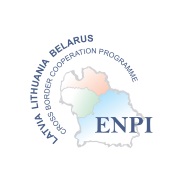E-MUSEUM “VITAMEMORIAE”: COLLECTION AND RESEARCH
Foto
To record people’s life stories, traditions, customs, rituals, rare photographs, old documents, ethnographic differences in funeral rites, etc. the researchers of Daugavpils University and Yanka Kupala Grodno State University carried out field studies in LV and BY territories: in the villages of Krāslava, Rēzekne, Daugavpils regions (Asūne, Foļvarka, Kruki, Skrudaliena, Indra, etc.) and in Belarus (Braslav and Vitebsk districts). The field studies were implemented in the framework of the project “Popularization of the Centres of Oral History in the LV – BY Cross-Border Area”, ID Nr. LLB–2–143, of the Cross Border Cooperation Programme Latvia–Lithuania–Belarus implemented within the framework of the European Neighbourhood and Partnership Instrument 2007–2013.
During the research and the expeditions, the project implementers collected, segmented, transcribed, and digitized the audio-visual materials (audio and video records, photo evidence). To make the collection of the E-Museum more complete, the field researchers and cemetery researchers of Daugavpils University and Grodno University will segment and systematize the audio-visual materials collected during oral history, cemetery research, folklore and dialectology expeditions of the previous years that until now have not been used, aiming at including the best and most valuable segments of the collection into the E-Museum.
The story tellers whose life stories make the input of the E-Museum are people of various generations, mostly elderly people. The childhood of aged people, who at present are about 80 years old, proceeded in the 1930s, therefore the segmented audio-visual units included in the E-Museum chronologically begin from 1929 and can describe only the respondents’ childhood memories. The memory of the older generation is particularly important for the anthropological and historical research – it shifts the time borders, allows for moving to the events of the past through the viewpoints of those who have experienced those times. The facts can be found in chronicles, but what the witnesses of that time can reveal give the memories colour, scent, involve one into mutual emotional experience. The witnesses of the epoch tell about the events form the viewpoint of their own experience.
To motivate the respondents to share their life stories, the project field researchers used Paul Thomson’s oral history research method – enlarged vision of social history where diverse groups of the society are brought together and share common historical experience.
The research basis is the methodology of a semi-structured interview that envisages focused (guided) reconstruction of the past events and an interviewer only helps the respondents to reconstruct the past.
The oral history collection of the E-Museum is envisaged to be used not only by specialists but also by a greatest possible range of non-specialists, therefore, departing from the academic tradition envisaging a complete script and transcript (written transcription of an audio or video record) of life stories, the project experts agreed to segment 360 most vivid, colourful, expressive, unusual, typological or extraordinary audio-visual units (photo, video and audio testimonies) – thematically complete excerpts, and to systematize them according to the thematic plan that would encompass both the historical processes of the 20th century (from the 1920s-30s) and the most essential events of an individual’s life.
ACCESSIBILITY OF THE COLLECTION
The interviews included into the collection are arranged according to the principle of historicism, anthropologism and personalia, indicating the author’s name and the interviewer’s name and surname.
-
About study and work in Latgale after World War II
Story-teller: “ I couldn’t, you see, I had finished six years of, what was then considered, Nautrēni primary school, it was six… six-year school. I couldn’t continue because …
Researcher: Dr. philol. Gatis Ozoliņš, Daugavpils Universitāte
Categories: Study and work, Antonina Ludborza
-
Аbout export of the sister to Germany in the years of World War II
Story-teller: “But my sister was taken away. I think, that was under such influence, that, you know … So it went, girls. We had the elder, the elder of our village, Kristinki village. He …
Researcher: Dr. philol. Gatis Ozoliņš, Daugavpils Universitāte
Categories: Confessional and international relations, Antonina Ludborza
-
About the wartime
Story-teller: “The war was going on. Our house was burned down during the war. We didn’t have a place to live in. We lived with our uncle. He also had a big family. At that time, when we …
Researcher: Dr. philol. Gatis Ozoliņš, Daugavpils Universitāte
Categories: End of the war, Antonina Ludborza
-
About the school years and parties
Story-teller: “Earlier, you know, I don’t know our, our, I mean, in our surroundings we had a school, exactly in our village and one teacher was from our village as well. But they …
Researcher: Dr. philol. Gatis Ozoliņš, Daugavpils Universitāte
Categories: Mode of life, Antonina Ludborza
-
Funeral. About Latvian and Russian daily life
Story-teller: “You see, when a man died, he was buried in a week’s time, so it was. So, thus the funeral feast, everything was prepared quickly. The coffin had to be made on the first day, …
Researcher: Dr. philol. Gatis Ozoliņš, Daugavpils Universitāte
Categories: Confessional and international relations, Antonina Ludborza
-
Аbout holidays in Latgale before World War II
Story-teller: “We celebrated Summer solstice not just two days, but three, yes! And all the holiday was celebrated for three days. Easter and Christmas were also three-days-long celebrations. …
Researcher: Dr. philol. Gatis Ozoliņš, Daugavpils Universitāte
Categories: First childhood memory, Antonina Ludborza
-
About "black" potter's craft
“The black pots – it is neither specific glaze, nor particular clay. Simply the process of firing is slightly different. They are in the same way, you’ve seen, that there are dishes, …
Researcher: Dr. philol. Gatis Ozoliņš, Daugavpils Universitāte
Categories: Study and work, Peteris Gailums
-
About kindling of the furnace in potter's craft
Story-teller: “So, and it is stoked there, from that side, in front at the lower end there is the furnace, lower, lower, lower, err, the furnace is at the lower end. But in the beginning that …
Researcher: Dr. philol. Gatis Ozoliņš, Daugavpils Universitāte
Categories: Study and work, Peteris Gailums
-
About potter's work
Story-teller: “The dishes should be absolutely dry to put them into the kiln, just like this. If they are like these ones and they are put into the kiln, they will certainly break. And then, …
Researcher: Dr. philol. Gatis Ozoliņš, Daugavpils Universitāte
Categories: Study and work, Peteris Gailums
-
Apdziedāšana
Kad ģērbj nelaiķi, ja tā ir sieviete, noteikti vajag lūk, šo galvas lakatiņu (косыночка – trīsstūrveida lakatiņš), bet pēc tam jau lakatu virsū. Bet mēs jau tagad kaut …
Researcher: Dr. philol. Jeļena Koroļova, Daugavpils Universitāte
Categories: Jefrosinja Ivanova, Svētki un tradīcijas










